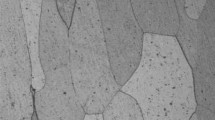Abstract
This investigation was conducted to determine the nature of the strain-rate sensitivity of OFHC copper at room temperature. In particular, the relative magnitudes of the dynamic contribution (particle inertia, suppression of thermal assistance, and so forth) and the nondynamic contribution (namely, the accelerated rate of strain hardening observed at high strain rates) to the strain-rate sensitivity were determined. Specimens were dynamically compressed using the Hopkinson pressure bar technique, and then were reloaded quasistatically to determine their respective yield strengths. The dynamic contribution to strainrate sensitivity was taken as the difference between the peak dynamic flow stress and the flow stress of the same specimen when reloaded quasistatically. The nondynamic contribution to strain-rate sensitivity of the flow stress was taken as the difference between the quasistatic flow stress in reloading of a specimen prestrained ε0 dynamically and the flow stress at ε0 for a sample deformed in uniaxial quasistatic compression. The room temperature dynamic flow-stress of OFHC copper, deformed at 500s−1, was found to be 25 pct higher than the conventional quasistatic flow stress for this metal over a strain range of 0.08 to 0.20. The nondynamic contribution to strain-rate sensitivity was found to be about 60 pct of the total flow stress increase and has been attributed to a difference in strainhardening at different strain rates. Thus, it appears that in OFHC copper at room temperature and at strain rates of about 500s−1, the nondynamic contribution to strain-rate sensitivity is more significant than the dynamic contribution.
Similar content being viewed by others
References
E. A. Ripperger:Proc. Colloq. on Behavior of Materials Under Dynamic Loading, 1965, pp. 62–80.
F. E. Hauser, J. A. Simmons, and J. E. Dorn:Proc. Tech. Conf. on Response of Metals to High Velocity Deformation, 1960, pp. 93-114.
U. S. Lindholm:Proc. Colloq. on Behavior of Metals Under Dynamic Loading, 1965, pp. 42–61.
J. C. Maiden and J. D. Campbell:Phil. Mag., 1958, vol. 3, p. 872.
R. N. Orava and H. E. Otto:J. Metals, Feb., 1970, vol. 22, pp. 17–31.
J. F. Bell:Proc. Colloq. on Behavior of Materials Under Dynamic Loading, 1965, pp. 19–38.
E. 0. H. Davies and S. C. Hunter:J. Mech. Phys. Solids, 1963, vol. 11, pp. 155–79.
U. S. Lindholm:J. Mech. Phys. Solids, 1964, vol. 12, pp. 317–35.
T. G. Glenn: M.S. Thesis, Department of Metallurgy, Colorado School of Mines, 1971.
S. J. Green, C. J. Maiden, S. G. Babcock, and F. L. Shierloh: Gens. Motors Report. MSL 69-36, pp. 1–34.
H.A. Korbel and K. Swiatkowski:Metal Sci. J., 1972, vol. 6, pp. 60–64.
Author information
Authors and Affiliations
Rights and permissions
About this article
Cite this article
Glenn, T., Bradley, W. The origin of strain-rate sensitivity in OFHC copper. Metall Trans 4, 2343–2348 (1973). https://doi.org/10.1007/BF02669373
Received:
Issue Date:
DOI: https://doi.org/10.1007/BF02669373




